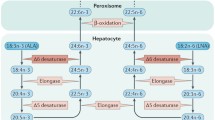Abstract
The n−3 polyunsaturated fatty acids (PUFA) have been shown to be antiarrhythmic in animals and probably in humans. PUFA stabilize the electrical activity of isolated cardiac myocytes by modulating sarcolemmal ion channels, so that a stronger electrical stimulus is required to elicit an action potential and the refractory period is markedly prolonged. Inhibition of voltage-dependent sodium currents, which initiate action potentials in excitable tissues, and of the L-type calcium currents, which initiate release of sarcoplasmic calcium stores, thus increasing cytosolic free calcium concentrations and activating the contractile proteins in myocytes, appears at present to be the probable major antiarrhythmic mechanisms of PUFA. Because the ion channels in neurons have channel proteins essentially homologous to those in the heart, the n−3 fatty acids would appear to be likely to affect the electrical activity in the brain in a manner similar to their effects in the heart, and accumulating evidence supports this notion. Evidence of important beneficial neurological effects of dietary n−3 PUFA are emerging with more likely to be discovered.
Similar content being viewed by others
Abbreviations
- CNS:
-
central nervous system
- DHA:
-
docosahexaenoic acid
- EPA:
-
eicosapentaenoic acid
- HEK:
-
human embryonic kidney
- IC50 :
-
50% inhibitory concentration
- PUFA:
-
polyunsaturated fatty acids
References
McLennan, P.L., Abeywardena, M.Y., and Charnock, J.S. (1988) Dietary Fish Oil Prevents Ventricular Fibrillation Following Coronary Artery Occlusion and Reperfusion, Am. Heart J. 116, 709–717.
Billman, G.E., Kang, J.X., and Leaf, A. (1999) Prevention of Ischemia-Induced Cardiac Sudden Death by Pure n−3 Polyunsaturated Fatty Acids, Circulation 99, 2452–2457.
Kang, J.X., and Leaf, A. (1994) Effects of Long-Chain Polyunsaturated Fatty Acids on the Contraction of Neonatal Rat Cardiac Myocytes, Proc. Natl Acad. Sci. USA 91, 9886–9890.
Li, Y., Kang, J.X., and Leaf, A. (1997) Differential Effects of Various Eicosanoids on the Production or Prevention of Arrhythmias in Cultured Neonatal Rat Cardiac Myocytes, Prostaglandins 54, 511–530.
Kang, J.X., and Leaf, A. (1995) Prevention and Termination Effect of the β-Adrenergic Agonist-Induced Arrhythmias by Free Polyunsaturated Fatty Acids in Neonatal Rat Cardiac Myocytes, Biochem. Biophys. Res. Commun. 208, 629–636.
Kang, J.X., and Leaf, A. (1996) Prevention and Termination of Arrhythmias Induced by Lysophosphatidyl Choline and Acylcarnitine in Neonatal Rat Cardiac Myocytes by Free Omega-3 Polyunsaturated Fatty Acids, Eur. J. Pharmacol. 297, 97–106.
Weylandt, K.H., Kang, J.X., and Leaf, A. (1996) Polyunsaturated Fatty Acids Exert Their Antiarrhythmic Actions as Free Fatty Acids Rather Than in Phospholipids, Lipids 31, 977–982.
Kang, J.X., and Leaf, A. (1996) Protective Effect of All-trans-Retinoic Acid Against Cardiac Arrhythmias Induced by Isoproterenol, Lysophosphatidylcholine or Ischemia and Reperfusion, J. Cardiovasc. Pharmacol. 297, 87–106.
Kang, J.X., Xiao, Y.F., and Leaf, A. (1995) Free Long-Chain Polyunsaturated Fatty Acids Reduce Membrane Electrical Excitability in Neonatal Rat Cardiac Myocytes, Proc. Natl. Acad. Sci. USA 92, 3997–4001.
Xiao, Y.-F., Kang, J.X., Morgan, J.P., and Leaf, A. (1995) Blocking Effects Polyunsaturated Fatty Acids on Na+ Channels of Neonatal Rat Ventricular Myocytes, Proc. Natl. Acad. Sci. USA 92, 1000–11004.
Xiao, Y.-F., Wright, S.N., Wang, G.K., Morgan, J.P., and Leaf, A. (1998) n−3 Fatty Acids Suppress Voltage-Gated Na+ Currents in Hek293t Cells Transfected with the α-Subunit of the Human Cardiac Na+ Channel, Proc. Natl. Acad. Sci. USA 95, 2680–2685.
Hille, B. (1977) Local Anesthetics: Hydrophilic and Hydrophobic Pathways for the Drug-Receptor Reaction, J. Gen. Physiol. 69, 497–515.
Xiao, Y.-F., Wright, S.N., Wang, G.K., Morgan, J.P., and Leaf, A. (2000) Coexpression with the β1-Subunit Modifies the Kinetics and Fatty-Acid Block of hH1α Na+ Channels, Am. J. Physiol. 279, H35-H46.
Xiao, Y.-F., Gomez, A.M., Morgan, J.P., Lederer, W.J., and Leaf, A. (1997) Suppression of Voltage-Gated L-Type Ca2+ Currents by Polyunsaturated Fatty Acids in Adult and Neonatal Rat Cardiac Myocytes, Proc. Natl. Acad. Sci. USA 94, 4182–4187.
Vreugdenhil, M., Breuhl, C., Voskuyl, R.A., Kang, J.X., Leaf, A., and Wadman, W.J. (1996) Polyunsaturated Fatty Acids Modulate Sodium and Calcium Currents in CA1 Neurons, Proc. Natl. Acad. Sci. USA 93, 12559–12563.
Voskuyl, R.A., Vreugdenhil, M., Kang, J.X., and Leaf, A. (1998) Anticonvulsant Effects of Polyunsaturated Fatty Acids in Rats, Using the Cortical Stimulation Model, Eur. J. Pharmacol. 31, 145–152.
Burr, M., Gilbert, J.F., Holliday, R.M., Elwood, P.C., Fehily, A.M., Rogers, S., Sweetnam, P.M., and Deadman, N.M. (1989) Effects of Changes in Fat, Fish, and Fibre Intakes on Death and Myocardial Reinfarction: Diet and Reinfarction Trial (DART), Lancet 334, 757–761.
de Lorgeril, M., Renaud, S., Mamelle, N., Salen, P., Martin, J.-L., Monjaud, I., Guidollet, J., Touboul, P., and Delaye, J. (1994) Mediterranean Alpha-Linolenic Acid-Rich Diet in Secondary Prevention of Coronary Heart Disease, Lancet 343, 1454–1459.
Siscovick, D.S., Raghunathan, T.E., King, I., Weinmann, S., Wicklund, K.G., Albright, J., Bovbjerg, V., Arbogast, P., Smith, H., and Kushi, L.H. (1995) Dietary Intake and Cell Membrane Levels of Long-Chain n−3 Polyunsaturated Fatty Acids and the Risk of Primary Cardiac Arrest, J. Am. Med. Assoc. 274, 1363–1367.
GISSI-Prevenzione Investigators (1999) Dietary Supplementation with n−3 Polyunsaturated Fatty Acids and Vitamin E After Myocardial Infarction: Results of the GISSI-Prevenzione Trial, Lancet 354, 447–455.
Hibbeln, J.R. (1998) Fish Consumption and Major Depression, Lancet 351, 1210–1213.
Stoll, A.L., Severus, E., Freeman, M.P., Rueter, S., Zboyan, H.A., Diamond, E., Gress, K.K., and Marangell, L.B. (1999) Omega 3 Fatty Acids in Bipolar Disorder: A Preliminary Double-Blind, Placebo-Controlled Trial, Arch. Gen. Psychiatry 56, 413–416.
Author information
Authors and Affiliations
Corresponding author
About this article
Cite this article
Leaf, A. The electrophysiologic basis for the antiarrhythmic and anticonvulsant effects of n−3 polyunsaturated fatty acids: Heart and brain. Lipids 36 (Suppl 1), S107–S110 (2001). https://doi.org/10.1007/s11745-001-0691-y
Received:
Accepted:
Issue Date:
DOI: https://doi.org/10.1007/s11745-001-0691-y




